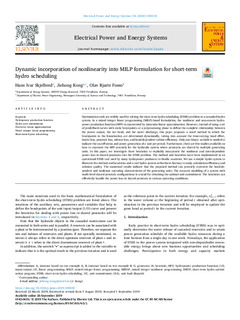| dc.contributor.author | Skjelbred, Hans Ivar | |
| dc.contributor.author | Kong, Jiehong | |
| dc.contributor.author | Fosso, Olav B | |
| dc.date.accessioned | 2019-11-27T07:57:18Z | |
| dc.date.available | 2019-11-27T07:57:18Z | |
| dc.date.created | 2019-09-23T08:41:32Z | |
| dc.date.issued | 2019 | |
| dc.identifier.issn | 0142-0615 | |
| dc.identifier.uri | http://hdl.handle.net/11250/2630660 | |
| dc.description.abstract | Optimization tools are widely used for solving the short-term hydro scheduling (STHS) problem in a cascaded hydro system. In a mixed integer linear programming (MILP)-based formulation, the nonlinear and non-convex hydropower production function (HPF) is represented by piecewise linear approximation. However, instead of using a set of predefined curves with static breakpoints or a preprocessing phase to define the complete relationship between the power output, the net head, and the water discharge, this paper proposes a novel method in which the breakpoints in the linearization are determined dynamically, taking into account the time-varying head effect, intake loss, penstock loss, tailrace loss, and head-dependent turbine efficiency. Only one binary variable is needed to indicate the on/off status and power generation of a unit per period. Furthermore, there are few studies available on how to represent the HPF precisely for the hydraulic system where penstocks are shared by multiple generating units. In this paper, we investigate three heuristics to explicitly incorporate the nonlinear and state-dependent power loss in shared penstocks into the STHS problem. The method and heuristics have been implemented in an operational STHS tool used by many hydropower producers in Nordic countries. We use a simple hydro system to illustrate the method and heuristics and a real hydro system in Northern Norway to study calculation efficiency and solution quality. The numerical results indicate that the proposed method can precisely represent the head-dependent and nonlinear operating characteristics of the generating units. The accurate modeling of a system with multi-level shared penstock configurations is crucial for obtaining the optimal unit commitment. The heuristics can effectively handle the power loss in shared penstock in various operating conditions. © 2019 Elsevier Ltd | nb_NO |
| dc.description.abstract | Dynamic incorporation of nonlinearity into MILP formulation for short-term hydro scheduling | nb_NO |
| dc.language.iso | eng | nb_NO |
| dc.publisher | Elsevier | nb_NO |
| dc.rights | Attribution-NonCommercial-NoDerivatives 4.0 Internasjonal | * |
| dc.rights.uri | http://creativecommons.org/licenses/by-nc-nd/4.0/deed.no | * |
| dc.title | Dynamic incorporation of nonlinearity into MILP formulation for short-term hydro scheduling | nb_NO |
| dc.type | Journal article | nb_NO |
| dc.type | Peer reviewed | nb_NO |
| dc.description.version | publishedVersion | nb_NO |
| dc.source.volume | 116 | nb_NO |
| dc.source.journal | International Journal of Electrical Power & Energy Systems | nb_NO |
| dc.identifier.doi | 10.1016/j.ijepes.2019.105530 | |
| dc.identifier.cristin | 1727605 | |
| dc.description.localcode | © 2019 The Authors. Published by Elsevier Ltd. This is an open access article under the CC BY-NC-ND license (http://creativecommons.org/licenses/BY-NC-ND/4.0/).T | nb_NO |
| cristin.unitcode | 194,63,20,0 | |
| cristin.unitname | Institutt for elkraftteknikk | |
| cristin.ispublished | true | |
| cristin.fulltext | original | |
| cristin.qualitycode | 1 | |

